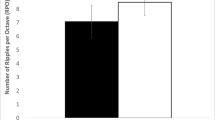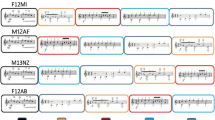Abstract
Both the alphabet and our system of musical notation are largely based on arbitrary conventions and associations. Conforming to the Dyslexic Automatization Deficit Hypothesis, children suffering from dyslexia are supposed to have difficulty in automating these types of conventions and/or associations. Scientific research into the relation between dyslexia and learning musical notation is rare. Therefore, we developed a new intervention paradigm on learning musical notation. This program was followed by five dyslexic children and four children without dyslexia, in order to study and compare the learning processes of both groups. The program consisted of instruction, practice in the skills and knowledge related to musical notation, and test assignments. During each session, the problem-solving process of the individual child was observed and the amount of time required to complete each assignment in the program was recorded. In addition we analyzed the errors made by the two groups of children in each session. A pretest-posttest comparison revealed that dyslexic children needed more time to learn musical notation than did children without dyslexia. Dyslexic children also made more mistakes and produced more ‘third transpositions’. The implications for teaching musical notation are outlined.
Similar content being viewed by others
References
American Psychiatric Association. Diagnostic and statistical manual of mental disorders, Fifth Edition. Washington, DC. American Psychiatric Association 1996.
Atterbury, B. W. 1983. A comparison of rhythm pattern perception and performance in normal and learning-disabled readers, age seven and eight. Journal of Research in Music Education 31(4):259–70.
Atterbury, B. W. 1984. Music teachers need your help. Journal of Learning Disabilities 17(2):75–77.
Brady, S. A., and Shankweiler, D. P. (eds.) 1991. Phonological Processes in Literacy. Hillsdale, NJ: Lawrence Erlbaum Associates.
Edgington, E. S. 1987. Randomization Tests (2nd Ed.). New York: Marcel Dekker.
Fawcett, A. J., Nicolson, R. I., and Dean, P. 1996. Impaired Performance of Children with Dyslexia on a Range of Cerebellar Tasks. Annals of Dyslexia 46:259–83.
Ganschow, L., Lloyd-Jones, J., and Miles, T. R. 1994. Dyslexia and Musical Notation. Annals of Dyslexia 44:185–202.
Gough, P. 1996. How children learn to read and why they fail. Annals of Dyslexia 46:3–20.
Haywood, H. C., and Tzuriel, D. (eds.) 1992. Interactive Assessment. New York: Springer Verlag.
Hubicki, M. 1994. Musical problems? Reflections and suggestions. In G. Hales, ed., Dyslexia Matters. London: Whurr Publishers.
Lidz, C. S. 1991. Practitioner’s Guide to Dynamic Assessment. New York: The Guilford Press.
Manis, F. R., Savage, P. L., Morrison, F. J., Horn, C. C., Howell, M. J., Szeszulski, P. A., and Holt, L. J. 1987. Paired associate learning in reading-disabled children: Evidence for a rule-learning deficiency. Journal of Experimental Child Psychology 43:25–43.
Morrison, F. J. 1993. Phonological processes in reading acquisition: Toward a unified conceptualization. Developmental Review 13:279–85.
Nicolson, R. I., and Fawcett, A. J. 1990. Automaticity: A new framework for dyslexia research? Cognition 35:159–82.
Nicolson, R. I., and Fawcett, A. J. 1994a. Comparisons of deficits in cognitive and motor skills among children with dyslexia. Annals of Dyslexia 44:147–64.
Nicolson, R. I., and Fawcett, A. J. 1994b. Reaction times and dyslexia. Quarterly Journal of Experimental Psychology 47A:29–48.
Nicolson, R. I., and Fawcett, A. J. 1995. Dyslexia is more than a phonological disability. Dyslexia: An International Journal of Research and Practice 1:19–37.
Oglethorpe, S. 1996. Instrumental Music for Dyslexics: A Teaching Handbook. London: Whurr Publishers.
Ruijssenaars, A. J. J. M. and Hamers, J. H. M. 1989. Assessment of Learning Ability. Learning Ability Tests and Analysis of Learning Processes. In H. Mandl, H. Bennet, E. De Corte, and A. F. Friedrich, eds., Learning and Instruction, Vol II. Oxford: Pergamon Press.
Scarborough, H. S. 1990. Very early language deficits in dyslexic children. Child Development 61:1728–43.
Stanovich, K. E. 1988. The right and wrong places to look for the cognitive locus of reading disability. Annals of Dyslexia 38:154–77.
Van den Broeck, W. 1997. Phonological Processes in Reading Development (Ph.D. diss.) University of Leiden.
Van Orden, G. C. and Goldinger, S. D. 1994. Interdependence of form and function in cognitive systems explains perception of printed words. Journal of Experimental Psychology: Human Perception and Performance 20:1269–91.
Visser, J., Laarhoven, A., and van Beek, A. 1996. AVI-toetspakket. Handleiding. ’s-Hertogenbosch: KPC.
Yap, R., and Van der Leij. 1994. Automaticity deficits in word reading. In R. I. Nicolson and A. J. Fawcett, eds., Dyslexia in Children: Multidisciplinary Perspectives. New York: Harvester Wheatsheaf.
Author information
Authors and Affiliations
Corresponding author
Rights and permissions
About this article
Cite this article
Jaarsma, B.S., Ruijssenaars, A.J.J.M. & Van den Broeck, W. Dyslexia and learning musical notation: A pilot study. Ann. of Dyslexia 48, 137–154 (1998). https://doi.org/10.1007/s11881-998-0007-4
Issue Date:
DOI: https://doi.org/10.1007/s11881-998-0007-4




